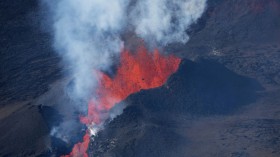Sahamalaza sportive lemurs, an endangered species of Madagascan lemur, use the alarm calls of birds and other lemurs to pick up on the presence of predators, according to researchers, who report the find as a first of its kind to confirm that lemurs can recognize the calls of a non-primate species.
There is a dearth of information about the Sahamalaza sportive lemur, though scientists do know that the creature spends most of the day roosting in very visible locations, such as tree holes, and seemingly puts itself at risk of predation from the ground and the air.
"We were seeking any information we could gather that could help us understand this species better, with the objective of improving targeted conservation efforts," said Melanie Seiler, a researcher at Bristol Zoo and the University of Bristol and lead author of the study.
Selier said that small, nocturnal species like the Sahamalaza sportive lemur are poorly understood and don't get much scientific or conservation attention.
Still, Selier and her team conducted a study demonstrating that the primates exhibited an increased state of vigilance when they heard recordings of the aerial alarm calls of other lemurs, looking upwards, indicating they understood the meaning of the calls. The same thing was found when other lemur calls were played for the Sahamalaza sportive lemur.
"Until our study, a solitary and nocturnal lemur species had never been tested to see if it could understand other species' alarm calls and differentiate between them," said Marc Holderied of the University of Bristol. "We were also the first to test any species of lemur to see if it could recognize the alarm calls of a non-primate species."
Holderied said: "Our results indicate that the Sahamalaza sportive lemur is capable of gleaning information on predator presence and predator type from the referential signals of different surrounding species. Examples for cross-species semantics in lemurs are rare, and this is the first record of lemurs using information across vertebrate classes."
The research is published in the journal PLOS ONE.
© 2024 NatureWorldNews.com All rights reserved. Do not reproduce without permission.





